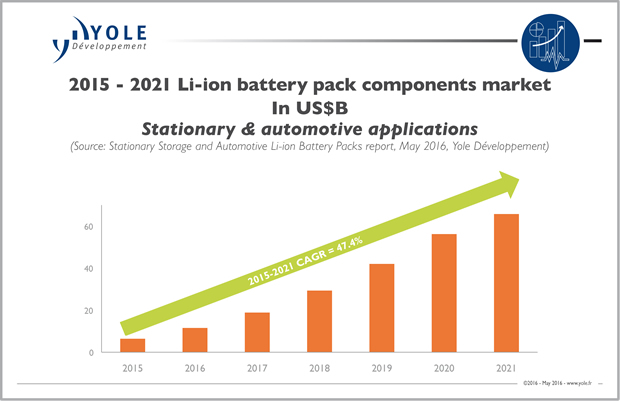Battery pack components; Companies seek better margins
Battery pack components are gaining importance in the fast-growing battery pack market, reaching $65.7bn by 2021. Cost decrease and performance improvements will directly impact the market and contribute to a larger adoption in many applications. Many companies have identified this potential and focused their R&D efforts on the development of disruptive technologies for Li-ion battery packs.
Whereas battery cells become a sort of 'standard' products, companies are developing new solutions for battery pack components in order to ensure the increase of their margins: the added-value in batteries spreads from battery cells to battery pack components.
Yole pursues its exploration of the battery world and releases this year a new report dedicated to the stationary batteries and plug-in HEV & BEV solutions. 'Stationary storage & Automotive Li-ion battery packs' report demonstrates the strong consistently-growing potential for power electronics players in the energy storage business based on Li-ion battery technologies. Yole’s team analyses market opportunities, supply chain technologies’ evolution and latest innovations for battery pack elements. This technology and market analysis is covering a large variety of different products and technology solutions used in battery packs elements.
The battery pack is the key element of battery storage systems. Such systems are used for clean mobility in hybrid electric vehicles and battery electric vehicles, and are crucial for the further deployment of intermittent renewable energy sources like wind and photovoltaics. Also, battery storage solutions are increasingly used in buildings and for electrical grid stabilisation. Demand for battery packs in these applications is growing rapidly and 2015-2021 CAGR for pack components will reach 47.4%, according to Yole’s stationary storage and automotive Li-ion battery pack report.

A main part of the battery pack demand will come from the automotive industry. In 2015 the demand in MWh for plug-in hybrid electric and battery electric vehicles was about 18x higher than for stationary applications. This ratio will remain almost unchanged by 2021 because both the automotive and stationary markets will feature strong growth. Stationary applications also present opportunities for companies with relatively small production capacities that are not compatible with automotive industry volumes but offer a higher differentiation/added value.
Today, the development of innovative battery technologies is focused mainly on battery cells as a key component of the battery pack. In fact, cells represent more than 50% of the battery pack cost. “Strongly decreasing cell costs will shift R&D efforts to other battery cost elements like BMS , thermal management and protection solutions,” commented Dr Milan Rosina, Senior Analyst Energy Conversion & Emerging Materials at Yole.
Many players with the know-how and/or manufacturing capacities for such technology solutions have already identified these business opportunities and are diversifying their activities into the battery pack business.







